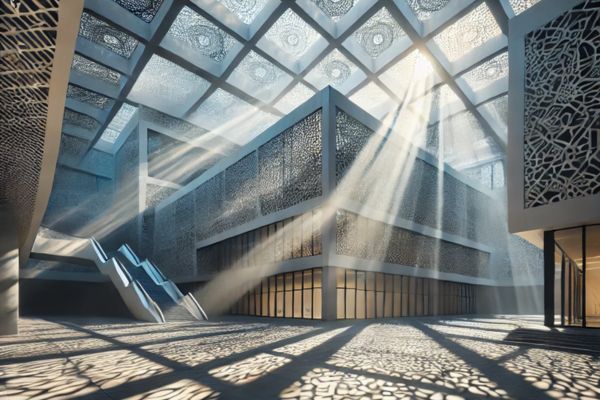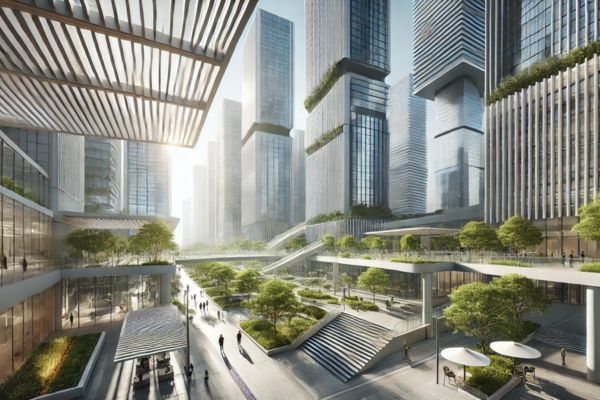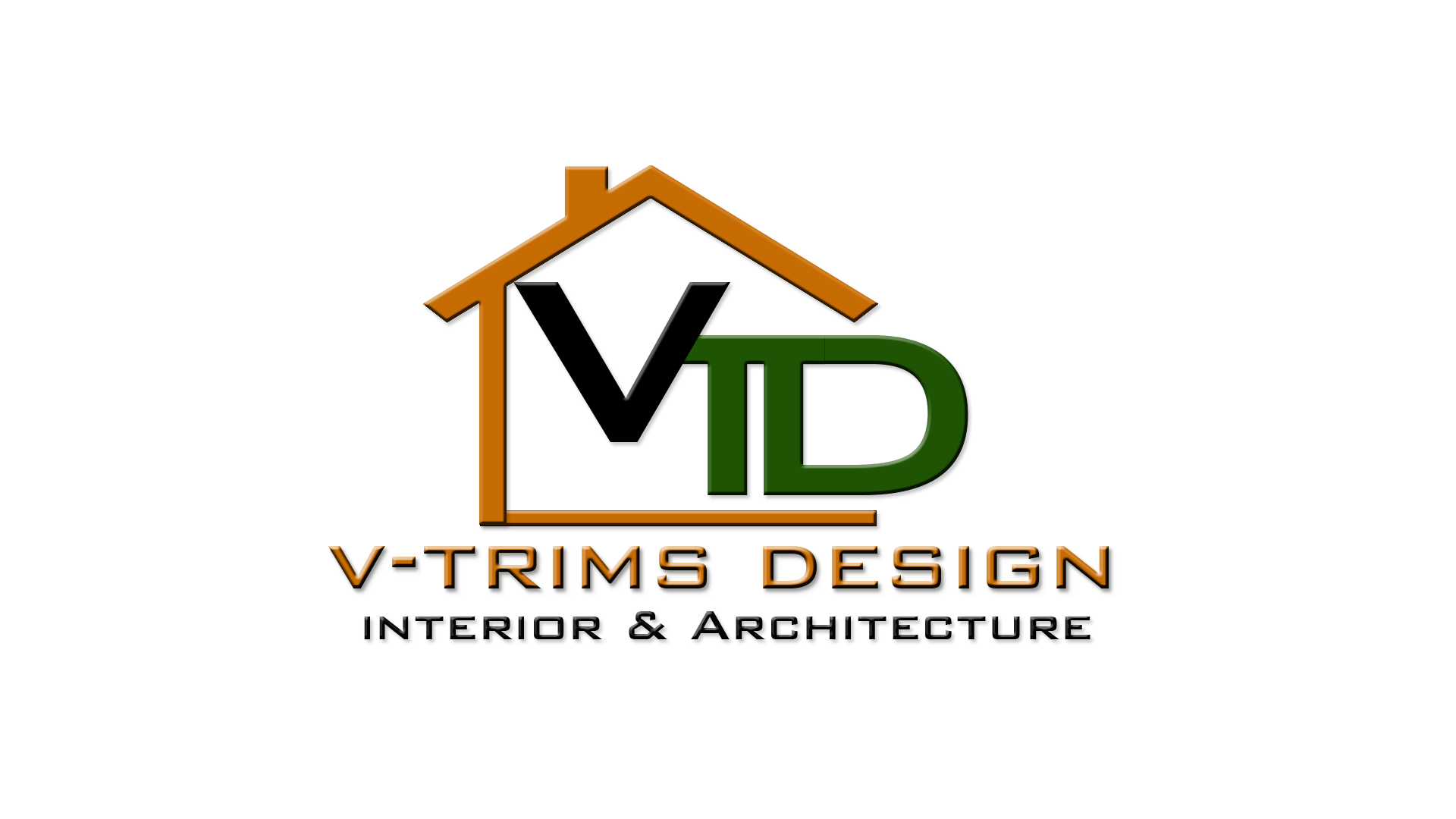NIKHIL GAMING.
1 month ago

In the world of architecture, the interplay between light and shadow defines the aesthetic and functional success of a design. Sciography, or the study of shadows, is a fundamental principle that architects use to enhance spatial perception, optimize natural lighting, and create dynamic visual effects. Whether designing a towering skyscraper or a minimalist home, understanding Sciography in Architectural Design is key to achieving harmony between illumination and darkness.
But why is sciography so crucial? Beyond its artistic appeal, it influences energy efficiency, spatial experience, and even the emotional impact of a building.
Sciography is derived from the Greek words skia (shadow) and grapho (to write), meaning the art of representing shadows. In architectural design, it involves analyzing how light interacts with different surfaces and how shadows evolve throughout the day and across seasons.
Shadows are not just passive byproducts of sunlight; they are active elements in defining a building’s form. When strategically incorporated, they can create depth, contrast, and even guide movement within a space. By studying sun paths, angles of incidence, and material reflectivity, architects can craft environments that respond dynamically to daylight.

One of the most visually striking aspects of sciography is its ability to transform architectural aesthetics. Light and shadow create rhythm, contrast, and texture, making a design feel alive.
Consider the intricate latticework in Islamic architecture or the sharp, geometric shadows cast by Brutalist buildings. These elements are not accidental; they are deliberate choices made by architects who understand how light interacts with form. Sciography allows designers to sculpt spaces with intangible yet powerful elements—light and shadow.
Modern architects like Tadao Ando and Louis Kahn have mastered sciography to perfection. Ando’s use of stark concrete planes and controlled apertures crafts a play of light that changes throughout the day, evoking a sense of serenity and movement.
Beyond aesthetics, sciography plays a crucial role in the functionality of buildings. The way light and shadow interact can influence everything from energy efficiency to human comfort. By mastering sciography, architects can create spaces that are not only visually appealing but also sustainable and comfortable.
Natural light is a precious resource in architecture, and sciography helps optimize its use. By carefully positioning windows, skylights, and shading devices, architects can control glare while maximizing illumination. This reduces reliance on artificial lighting, lowering energy consumption and improving indoor comfort.
Strategic shadow placement helps regulate indoor temperatures by minimizing excessive heat gain in warm climates and maximizing solar gain in cooler regions. Passive design strategies, such as overhangs, louvers, and pergolas, leverage sciography to enhance energy efficiency without mechanical interventions.
Light and shadow influence human perception and emotions. Bright, well-lit spaces promote alertness and positivity, while dimmer, shadowed areas create intimacy and relaxation. This is why museums, religious buildings, and homes use sciographic principles to craft atmospheres that evoke specific feelings.

Beyond individual buildings, sciography plays a crucial role in urban design. Cities must consider the movement of shadows cast by skyscrapers and public structures to ensure that streets, parks, and gathering spaces remain comfortable and inviting.
In high-density urban areas, poorly planned buildings can cast long, disruptive shadows, reducing daylight access for surrounding structures. Thoughtful sciographic analysis ensures that pedestrian pathways remain well-lit, solar panels receive sufficient exposure, and green spaces flourish with balanced light distribution.
Architects today have access to advanced digital tools that make sciographic analysis more precise than ever. Some of these include:
By integrating these tools, designers can predict and manipulate light and shadow with incredible accuracy, ensuring that every space is both functional and visually captivating.

Throughout history, architects have skillfully leveraged sciography to create breathtaking designs that blend light and shadow seamlessly. From ancient temples to modern skyscrapers, the strategic use of shadows has played a crucial role in shaping spatial experiences. Below are three remarkable examples that highlight the brilliance of sciographic application in architecture.
The oculus at the Pantheon’s dome is a perfect example of sciographic mastery. The shifting beam of light that enters through the oculus changes throughout the day, creating a celestial experience that enhances the sacredness of the space.
This iconic house is designed with cantilevered terraces that cast dynamic shadows over the flowing waterfall below, seamlessly integrating architecture with nature.
Mastering sciography in architectural design is not just about casting beautiful shadows—it’s about creating sustainable, comfortable, and emotionally resonant spaces. From enhancing natural light to reducing energy consumption, sciography is a crucial tool that elevates both form and function.
At V-Trims Design, we believe that great architecture is a delicate balance of light and shadow. Whether you’re designing a new home, an office space, or an urban plaza, our experts can help you integrate sciography to maximize aesthetics and efficiency.
Looking to bring the magic of light and shadow into your architectural projects? Contact the best architecture firm in Lucknow today and let’s craft spaces that shine—literally!
5 months ago
VTRIM Design isn’t just designing buildings — they’re designing experiences, stories, and lifestyles. Highly recommended for anyone who values quality, aesthetics, and integrity in architecture.
6 months ago
Gajab ke designer h mera ghar bnaya h jabse roz dekh ke unhi ko yad krta hu kya bnaya h.
6 months ago
Best architecture firm in Lucknow. Exceptionally good in terms of designing and service standards. Professionalism and dedication towards each project is outstanding. I Wish them great success in future. Highly recommended go for v-Trims design
6 months ago
VTRIM Design isn’t just designing buildings — they’re designing experiences, stories, and lifestyles. Highly recommended for anyone who values quality, aesthetics, and integrity in architecture.
6 months ago
Best interior designer in lucknow and best creativity work in interior design
6 months ago
I'm painter and i have been working for long time with v-trims design . This fir is done many attractive projects
6 months ago
"VTRIMS Design truly listens to your needs and offers creative solutions. Their team is very responsive and skilled. Highly professional."
6 months ago
Excellent company.The team is young,talented,and very passionate about design
6 months ago
"If you're looking for modern and elegant interiors, VTRIMS Design is the go-to place. Loved their approach, especially the 3D visuals before execution."
6 months ago
⭐⭐⭐⭐⭐ "From concept to completion, everything was handled with perfection. The team is young, talented, and very passionate about design."
6 months ago
⭐⭐⭐⭐⭐ "Loved working with them! My kitchen and dining space look like something out of a magazine. Superb craftsmanship."
6 months ago
It's nice company work is very fast trustable company Clint always happy interior design so attractive and amazing team all good❤️❤️
6 months ago
⭐⭐⭐⭐⭐ "Very professional team! They handled my 3BHK interior project beautifully. Timely delivery and unique designs. Thank you VTRIMS Design."
6 months ago
"Very professional team! They handled my 3BHK interior project beautifully. Timely delivery and unique designs. Thank you VTRIMS Design."
6 months ago
"Brilliant design, smooth execution and a truly professional team. They turned our vision into a beautiful, functional space we know call home . Highly recommended! "
6 months ago
V Trims is a firm with young and dynamic Architects who are very innovative in designing. They make very good looking contemporary structures with clean finish
6 months ago
Exceptional creativity and execution! The design team perfectly understood our vision and brought it to life with style and functionality. Professional, detail-oriented, and truly passionate about their work. Highly recommended for anyone looking to elevate their space!
6 months ago
They are doing very well construction finishing as welll best wishes for future endeavours
6 months ago
it's too good . There way of talking there designs everything is totally wonderful you all will like their presentation
6 months ago
First of all thanks for V trims design team provided good quality of work unique design i have batter expression with them this credit total goes to Ar vinod Chauhan sir
6 months ago
Just wanted to say a sincere thank you for all the work you have done for us in creating our amazing new space. We love it and were continually impressed by your professionalism, attention to detail, care and the support you provided us during this project. You made the process so easy for us and we are very grateful.
6 months ago
The man behind V-Trims is wow....Hire & give your dream home or Project a wow !!
6 months ago
Keep it up, you’re doing a great job in building architectures. All the best.
6 months ago
"V Trims Design Company is a game-changer in the architectural design field, delivering innovative and functional designs that exceed expectations. Their expertise and attention to detail make them a top choice for any design project."
6 months ago
"Highly impressed every detail reflected thoughtful design and quality craftsmanship.
6 months ago
"Highly impressed with their creativity and professionalism! Good working company... 💪
6 months ago
"Highly impressed with their creativity and professionalism! The team delivered a perfect blend of aesthetics and functionality. Every detail reflected thoughtful design and quality craftsmanship.
6 months ago
Every detail, from the foundation to the finishing, shows top-notch craftsmanship of V-Trims Designs.
6 months ago
"Very professional team! They handled my 3BHK interior project beautifully. Timely delivery and unique designs. Thank you VTRIMS Design."
6 months ago
V-trims Design (Architectural & Interior Design) deals all types of building design, interior design, survey, layout plans for plottings. They provide best quality service at affordable price in U.P.
6 months ago
V-Trims provides exceptional service with a team that's responsive and professional. Their attention to detail and commitment to quality make them a top choice for Architect and interior design.
6 months ago
The firm and its supporting team are genuinely sincere and dedicated.
6 months ago
A really great firm with amazing designs with state of the art features. Decent cost and one of the most disciplined and dedicated team an individual as a client can ask for with very smooth execution.
6 months ago
Sir your work is very beautiful The interior design you have done is beyond comparison. The elevations you have made, the plantation you have done and your team working is very good. I pray to Allah that you get a lot of success.
6 months ago
The trendsetting and innovative architectural capabilities of Vinod and his team set them apart as leaders in the industry.
6 months ago
They managed the project effectively, keeping us on schedule and within budget." or "We were particularly impressed with their ability to adapt to unexpected challenges." "They skillfully addressed any challenges that arose during the project, finding creative solutions."
6 months ago
One of the best architect firm in lucknow There is a lot of cleanliness in their work, all the staff is experienced and well trained, I will always recommend V trims to everyone
6 months ago
"From concept to completion, everything was handled with perfection. The team is young, talented, and very passionate about design."
6 months ago
Very good experience with v-trim team and good supportive team for all the movement to built your dream home...Thanks v-trims ...🙏🙏
6 months ago
Top best Architect for lucknow please contact to V trims Design for every type of Buildings design & Interior/Exterior designing......
6 months ago
Here's a 5-star rating review for V-Trims Design | Architect & Interior: ⭐⭐⭐⭐⭐ Exceptional Design and Professionalism! I had an amazing experience working with V-Trims Design. Their attention to detail, innovative ideas, and seamless execution truly set them apart. From the initial consultation to the final touches, their team was professional, creative, and responsive to every need. They transformed my space into something both beautiful and functional, exceeding my expectations in every way. Highly recommended for anyone looking for top-tier architectural and interior design services!
6 months ago
"VTRIMS design transformed my home into a dream space! Their attention to details and creativity blew me away . Highly recommended for premium interior design in lucknow .
6 months ago
"VTRIMS Design transformed my home into a dream space! Their attention to detail and creativity blew me away. Highly recommended for premium interior design in Lucknow."
6 months ago
"If you're looking for modern and elegant interiors, VTRIMS Design is the go-to place. Loved their approach, especially the 3D visuals before execution."
6 months ago
Very professional team! They handled my 3BHK interior project beautifully. Timely delivery and unique designs. Thank you VTRIMS Design.
8 months ago
"One of the rare firms that balance creativity, technology, and budget without compromising quality. Absolutely worth it!"
11 months ago
Top-Tier Architectural Expertise in Lucknow! Vtrims Design is undoubtedly one of the best architecture firms in Lucknow, offering innovative and aesthetically stunning designs that perfectly blend functionality with creativity. As a leading architect in Lucknow, their team excels in residential, commercial, and interior design projects, delivering outstanding results tailored to client needs. Their expertise in modern architectural solutions, space planning, and sustainable designs sets them apart. Whether you're looking to design a luxurious home, a contemporary office, or a commercial space, Vtrims Design ensures every project is executed with precision and excellence. If you're searching for a trusted and experienced architect in Lucknow, look no further than Vtrims Design. Their professionalism, attention to detail, and commitment to quality make them the go-to choice for architectural services. Highly recommended!
V-Trims Design is an architectural design and construction company in Lucknow founded by young entrepreneurs with a love of design and the belief that every home should be designed to impress and that every person should have a designer lifestyle.
